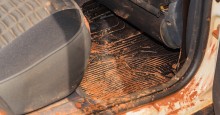
Children playing in muddy puddle. Photo ID 127929357 © Joruba | Dreamstime.com
Concerns related to odors and mold persist in vehicles throughout the year, but as cold weather settles in, they can bring different challenges to drivers.
- New vehicles [1]
- Used vehicles [2]
Prolonged exposure to the elements and moisture, both within the vehicle's interior and its systems, can cause significant problems for your car, as well as potential health implications for yourself.
What exactly is that smell?
If you've experienced cold climates for any length of time, chances are you've encountered that musty odor upon entering a car. This smelly situation is particularly common with older models or vehicles stored outdoors during winter. Various issues can contribute to these peculiar smells.
During winter, one main cause for odor is moisture accumulation in the air conditioning and ventilation system. Inactivity allows this moisture to foster a stale odor and, if left untreated, it may lead to more mold.
Running your AC on high for a mile or more might sometimes alleviate the issue. If the odor persists or quickly returns, it could indicate a more significant problem like a leak or clog. In such cases, consult your mechanic for a thorough inspection.
Another potential source of the smell is the cabin air filter, which can become dirty and musty over time. Regular replacement is crucial and is usually something that can be done during your car’s scheduled oil changes.
Filters not only harbor mold but also accumulate dust and pollen, exacerbating allergies and respiratory problems.

Wet, dirty car mats. Photo ID 87870973 © Vinicius Bacarin | Dreamstime.com
Changing the cabin air filter every 12 months or 12,000 miles, or sooner if you detect unusual smells or debris entering the interior when using the vents, is essential. This routine maintenance not only ensures clean and healthy air but also enhances heating and AC performance, along with defogging capabilities.
Outside elements can cause an odor issue inside
The source of unpleasant odors in your car may not necessarily be the vehicle itself; it could be the result of actions by the driver.
If you or someone in your car consumes food or drinks, there's a possibility that food particles or liquid may have fallen beneath a seat or into the interior's crevices. Unnoticed, these areas could breed mold, contributing to your car’s unpleasant smell.
Also, food smells may be absorbed by the vehicle's fabrics.
In the event of a flood, mold can be a lingering issue for your vehicle even if you believe it was completely dried out. Especially in older models, the floorboards and carpets may have absorbed moisture, leading to mold development.
Water seeping into sealed compartments that house wiring and circuitry could result in significant electrical problems, in addition to causing unpleasant odors.
Another potential source of unpleasant smells could be wet clothes or sweaty gym gear left in your car. Damp or dirty clothes placed on your vehicle's fabrics or carpets, may transfer moisture and germs, adding to your car’s odor problem.
Mold is the silent enemy
With over 100,000 different species, mold manifests in diverse forms and colors.
Among the spectrum of mold colors, black is often the most recognized and feared. While not all black mold is toxic, certain strains can indeed be dangerous, causing severe health problems and even death.
Yellow and green mold are also common colors, and these, along with others, have the potential to be toxic. It's imperative to treat all molds seriously and address them promptly and thoroughly.
Contrary to the common belief that they only thrive in warm environments, molds have adapted to survive and grow in various climates, including colder temperatures, even within the confines of your car.
Mold can initiate growth within 24 hours of exposure to moisture. Left unchecked, it can wreak havoc on your car's interior and pose health risks.
The presence of dreaded toxic mold can escalate the problem significantly, potentially leading to symptoms such as vomiting, lung bleeding, and fatigue, particularly for individuals with compromised immune systems or a history of respiratory issues.
If you are concerned about the specific mold you are dealing with or may be exposed to, there are numerous test kits available. Basic testing kits help identify the presence of mold, while more advanced tests can pinpoint the species and assess toxicity levels.
Below are a few tips to help prevent interior mold and smells from taking over your vehicle:
- When not in use, if possible, park your car in a garage or an enclosed structure to minimize exposure to the elements and outside moisture.
- Regularly inspect your vehicle for leaking areas that may let moisture in. Check the seals on doors and windows, and promptly address any identified issues.
- For convertible owners, ensure the roof closes properly, is undamaged, and doesn't trap liquid in the top system.
- Run the air conditioning intermittently in winter to circulate air through the system and prevent moisture buildup.
- Always ensure doors and windows are securely closed when your car is not in use.
- Avoid eating and drinking in the vehicle, but if you do, try to prevent spills, and promptly clean any mess.
- Check floor mats for wet spots or puddles after exposure to snow, mud, or rain. Remove and clean mats if needed, allowing them to dry completely before reinstallation.
- Regularly wipe down and clean the interior of your vehicle.
- Remove and store sweaty workout clothes, wet towels, or musty items elsewhere, not in the car.
- Be cautious about using air fresheners and sprays to mask odors. Address the root cause, as persistent issues can harm your interior and potentially impact your health.
- Consider using waterproof mats for adverse weather conditions. Installing waterproof mats instead of carpet mats can be effective in preventing mold but remember to clean them thoroughly as water and mold can accumulate in crevices.
Mike Pennington of Meguiar’s offers the following suggestions for keeping your car’s interior clean.
For cloth materials:
- Remove spills or grime with a cotton terry cloth towel. Make sure it does not sit for an extended period of time.
- Use a stiff nylon brush to scrub the material to prevent stiff and unattractive upholstery.
- Before applying cleaning solutions, remove grime by vacuuming first.
- Then lightly spray on your cleaning solution, making sure not to soak the surface.
- Scrub the area again using a clean brush.
- Lastly, dab the area using a clean terry cloth towel.
For leather and vinyl:
- Use wipes or sprays made specifically for these surfaces.
- First, use a terry cloth towel to wipe the surface.
- Spray the cleaner on a terry cloth towel then wipe down the affected surfaces. The process helps prevent overspray, which becomes a dirt magnet.
- Then apply a leather and vinyl reconditioner to keep surfaces in good condition.
For rubber materials:
- First remove soil and grime from the rubber surface.
- Then wipe down the area with an all-purpose cleaning wipe or quick detailing solutions designed for auto interiors.
- To ensure the health of the material, apply a rubber treatment as cleaners may strip rubber material of its protection.